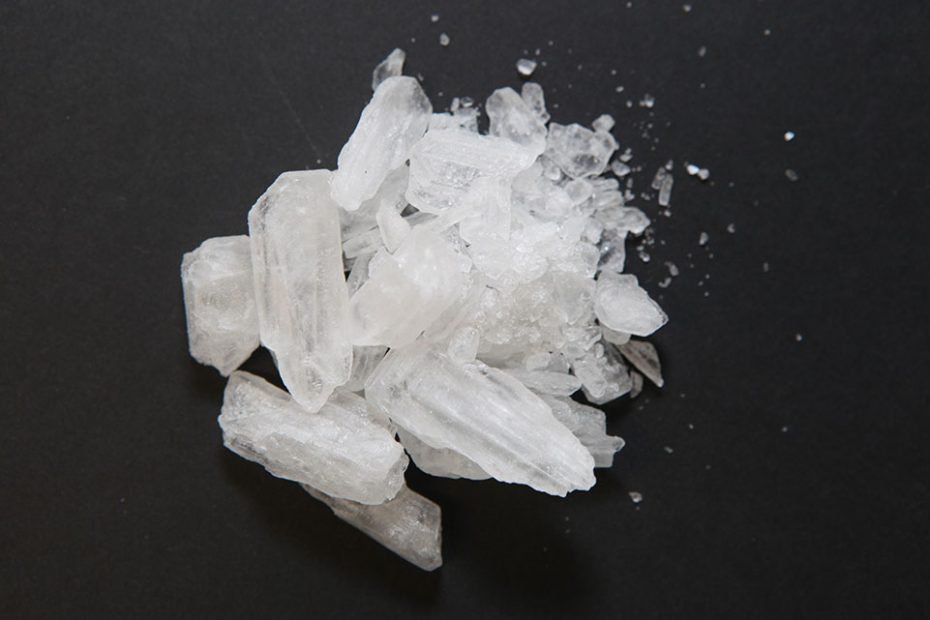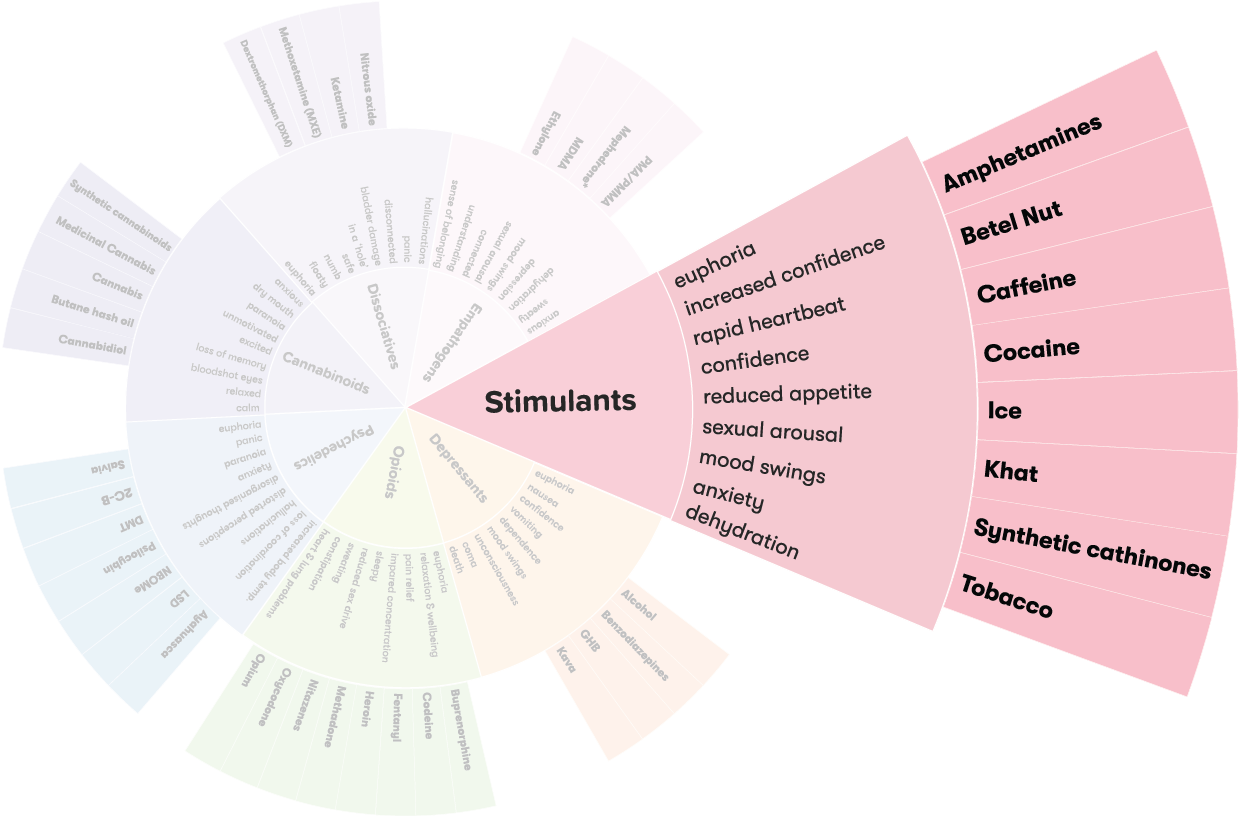How are amphetamines used?
Amphetamines are generally swallowed, injected or smoked. They are also snorted.6
Effects of amphetamines
Use of any drug can have risks. It’s important to be careful when taking any type of drug.
Amphetamines affect everyone differently, based on:
- size, weight and health
- whether the person is used to taking it
- whether other drugs are taken around the same time
- the amount taken
- the strength of the drug (varies from batch to batch with illegally produced drugs).
You might feel the effects of amphetamines immediately (if injected or smoked) or within 30 minutes (if snorted or swallowed).You might experience:
- happiness and confidence
- talking more and feeling energetic
- large pupils and dry mouth
- fast heartbeat and breathing
- teeth grinding
- reduced appetite
- increased sex drive.6-8
Research has found an association between amphetamine use and increased violent behaviour.9
Snorting amphetamines can damage the nasal passage and cause nose bleeds.
If injecting drugs, there is an increased risk of:
- tetanus
- infection
- vein damage and blood clots.10, 11
If sharing needles, there is an increased risk of:
- hepatitis B.
- hepatitis C.
- HIV and AIDS.12
Overdose
If you take a large amount or have a strong batch, you could overdose.
Call an ambulance straight away by dialling triple zero (000) if you or someone else has any of the following symptoms (ambulance officers don’t need to involve the police):
- racing heartbeat
- fits
- passing out or breathing difficulties
- chills or fever
- no urine output
- arching of the back/convulsions
- stroke, heart attack and death.6, 7
Coming down
In the two to four days after amphetamine use, you may be experience:
- restless sleep and exhaustion
- headaches
- paranoia, hallucinations and confusion
- twitching and muscle aches
- fluctuating temperatures
- irritability, mood swings, anxiety and depression.
Using a depressant drug such as alcohol, benzodiazepines or cannabis to help with the come down effects may result in a cycle of dependence on both types of drugs.
Mixing amphetamines with other drugs
Mixing amphetamines with other drugs can have unpredictable effects and increase the risk of harm.
- Amphetamines and opioids: can increase the risk of heart strain and respiratory arrest.
- Amphetamines and MDMA: can cause anxiety, heart strain, and increased neurotoxic effects.
- Amphetamines and cocaine: can cause anxiety, heart strain which can lead to stroke.
- Amphetamines and benzodiazepines: can decrease/mask the effects of both. Risk of overdose if one wears off before the other – depending on amount taken.
- Amphetamines and alcohol: may feel less intoxicated due to stimulant effects of amphetamine and lead to drinking more. Increases risk of alcohol poisoning.13,14,15
More on Polydrug use
Polydrug use is a term for the use of more than one drug or type of drug at the same time or one after another. Polydrug use can involve both illicit drugs and legal substances, such as alcohol and medications.
Reducing harm
There are ways in which you can reduce the risks associated with using amphetamines:
- Always test a small amount first and wait to feel effects before taking more.
- Try to eat regularly even if you are not hungry. Eat fresh healthy food such as fruit and vegetables that are high in vitamins and nutrients.
- Try to rest and get sleep.
- Stay hydrated. People can become dehydrated when using amphetamines, take small sips of water regularly.
- Avoid if you have a history of mental health issues.
- Regular use of amphetamines can increase the risk of heart attack or other heart problems. Using less frequently and smaller amounts of amphetamines may reduce this risk.17
Long-term effects
Regular use of amphetamines may eventually cause:
- reduced appetite and extreme weight loss
- restless sleep
- dry mouth
- dental problems
- regular colds and flu
- anxiety and paranoia
- depression
- increased risk of stroke
- tolerance and dependence on amphetamines
- financial, work and social problems.2, 6-8
Amphetamine use and mental health
Research demonstrates a relationship between people who use amphetamines and increased mental health issues.9
High doses and frequent heavy use can also create a ‘amphetamine-induced psychosis’, characterised by paranoid delusions, hallucinations and out of character aggressive or violent behaviour.9
These symptoms usually disappear after the person stops using amphetamines.41,2
Withdrawal
Giving up amphetamines after a long time is challenging because the body has to get used to functioning without them.
Withdrawal symptoms should settle down after a week and will mostly disappear after a month. Symptoms include:
- cravings for amphetamines
- increased appetite
- confusion and irritability
- aches and pains
- exhaustion
- restless sleep, vivid dreams and nightmares
- anxiety, depression and paranoia.4, 6
Getting help
If your use of amphetamines is affecting your health, family, relationships, work, school, financial or other life situations, or you’re concerned about a loved one, you can find help and support.
Call the National Alcohol and Other Drug Hotline on 1800 250 015 for free and confidential advice, information and counselling about alcohol and other drugs
Help and Support Services search
Find a service in your local area from our list. Simply add your location or postcode and filter by service type to quickly discover help near you.
If you're looking for other information or support options, send us an email at druginfo@adf.org.au
Path2Help
Not sure what you are looking for? Try our intuitive Path2Help tool and be matched with support information and services tailored to you.
Find out more
Use of meth/amphetamines is against the law. Federal and state laws provide penalties for possessing, using, making, selling, importing or exporting, or driving under the influence of meth/amphetamines.
The importation or exportation and the procuring of precursor drugs (such as pseudoephedrine) with the intention of manufacturing a controlled drug, is also against the law. Laws have been introduced that prevent the sale and possession of ice pipes in some states and territories.18
See also, drugs and the law.
In 2019, 5.8% of Australians had used meth/amphetamines at least once in their lifetime (approximately 1.2 million).
In 2019, 1.3% of Australians had used meth/amphetamine in the last 12 months.
The average age that Australians first try meth/amphetamine is 22.
The age group most likely to use meth/amphetamine is 20-29.
The main forms used are: crystal/ice - 50%, powder/speed - 19.9%.19
- Marshman JA, Brands B, Sproule B, Jacobs MR. Drugs & drug abuse: a reference text. 3rd ed. Marshman JA, Brands B, Sproule B, Jacobs MR, Kevin O'B F, Addiction Research Foundation of Ontario, editors. Toronto: Addiction Research Foundation; 1998.
- Darke S, Lappin J, Farrell M. The Clinician's Guide to Illicit Drugs and Health Great Britain: Silverback Publishing; 2019.
- Castells X, Blanco-Silvente L, Cunill R. Amphetamines for attention deficit hyperactivity disorder (ADHD) in adults. Cochrane Database Syst Rev. 2018;8:CD007813-CD.
- Ruiz P, Strain EC. Substance Abuse Handbook. Philadelphia: Wolters Kluwer Health; 2014.
- Preedy VR. Neuropathology of drug addictions and substance misuse: Volume 2, Stimulants, club and dissociative drugs, hallucinogens, steroids, inhalants, and international aspects. Preedy VR, editor. Amsterdam: Academic Press; 2016.
- Campbell A. The Australian illicit drug guide: every person's guide to illicit drugs - their use, effects and history, treatment options and legal penalties. Melbourne: Black Inc; 2001.
- Marshman JA, Brands B, Sproule B, Jacobs MR. Drugs & drug abuse : a reference text. 3rd ed. ed. Marshman JA, Brands B, Sproule B, Jacobs MRartrbMRJ, Kevin O'B F, Addiction Research Foundation of O, editors. Toronto: Addiction Research Foundation = Fondation de la recherche sur la toxicomanie; 1998.
- Upfal J. Australian drug guide: the plain language guide to drugs and medicines of all kinds. 8th ed. Carlton, Vic, Australia: Black Inc., an imprint of Schwartz Publishing Pty Ltd; 2016.
- McKetin R, Leung J, Stockings E, Huo Y, Foulds J, Lappin JM, et al. Mental health outcomes associated with the use of amphetamines: A systematic review and meta-analysis. EClinicalMedicine. 2019;16:81-97.
- Colledge S, Larney S, Bruno R, Gibbs D, Degenhardt L, Yuen WS, et al. Profile and correlates of injecting-related injuries and diseases among people who inject drugs in Australia. Drug and alcohol dependence. 2020;216:108267-.
- Hahné SJM, White JM, Crowcroft NS, Brett MM, George RC, Beeching NJ, et al. Tetanus in injecting drug users, United Kingdom. Emerg Infect Dis. 2006;12(4):709-10.
- Degenhardt L, Charlson F, Stanaway J, Larney S, Alexander LT, Hickman M, et al. Estimating the burden of disease attributable to injecting drug use as a risk factor for HIV, hepatitis C, and hepatitis B: findings from the Global Burden of Disease Study 2013. Lancet Infect Dis. 2016;16(12):1385-98. 13. Hi-Ground. Amphetamines n.d. [cited: 12.12.2022].
- Harm Reduction Victoria. Speed n.d. [cited: 12.12.2022].
- Psychonaut Wiki. Amphetamine 2022 [cited: 12.12.2022].
- World Health Organisation. Lexicon of Alcohol and Drug Terms. World Health Organisation; 1994.
- Government of Western Australia Mental Health Commission. Harm Reduction Tip Sheet for Workers - Amphetamines n.d. [cited: 14.11.2022].
- DRUGS, POISONS AND CONTROLLED SUBSTANCES ACT 1981 - SECT 36B, (n.d.).
- Australian Institute of Health and Welfare. National Drug Strategy Household Survey 2019 2020 [09.09.2020].

